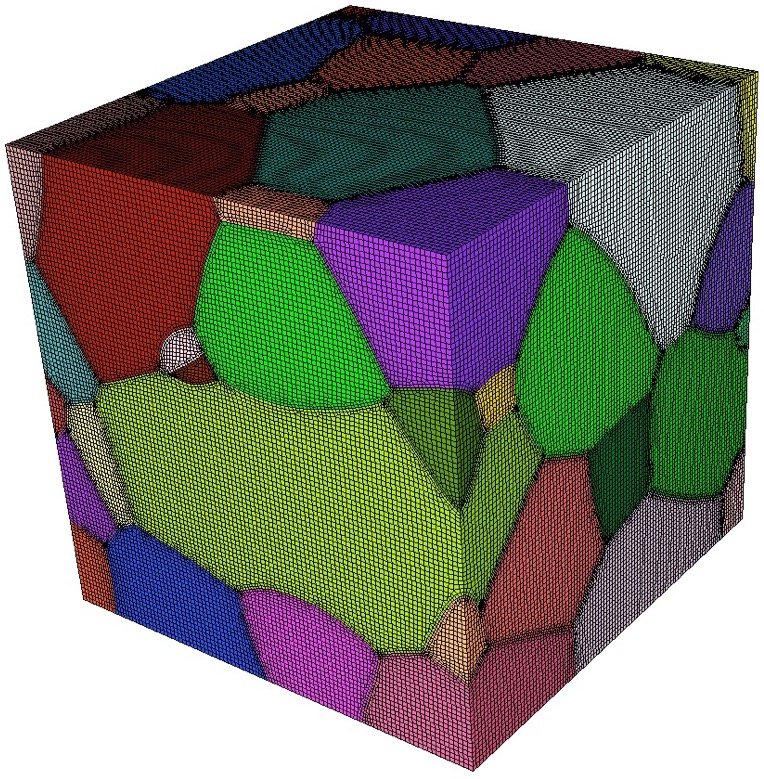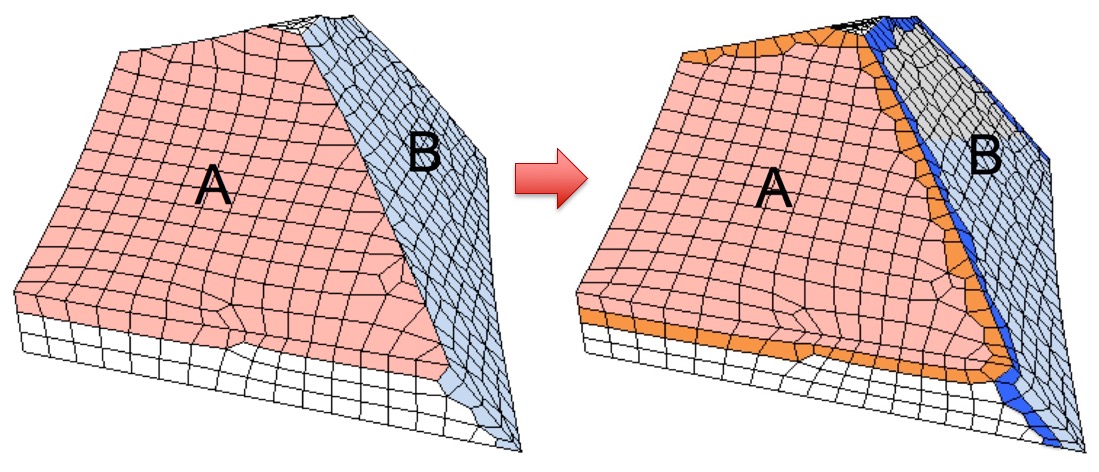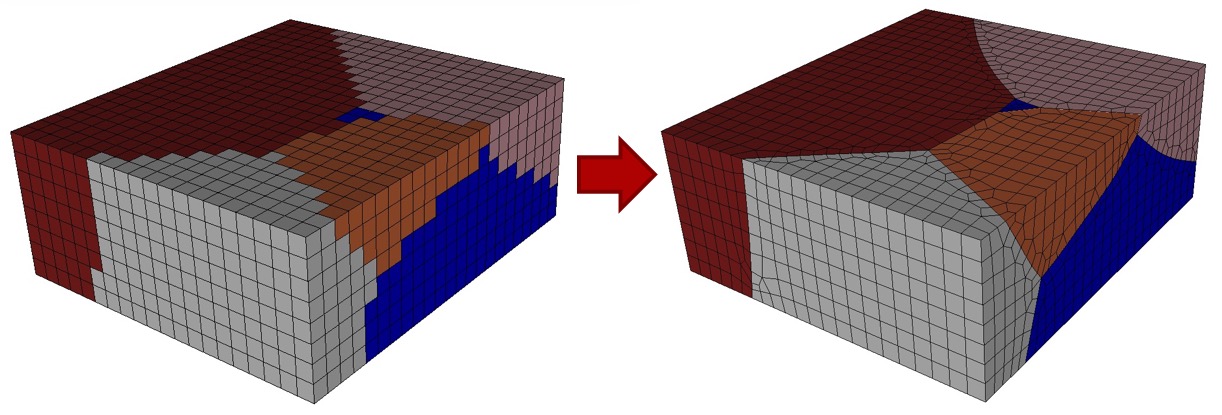Cubit
15.3 User
Documentation![]()
Cubit
15.3 User
Documentation![]()
Options for specifying input files to Sculpt. Sculpt uses a method for representing geometry based upon volume fractions defined on a Caresian grid. Sculpt will accept facet-based (STL) or analytic (diatom) geometry, but will first convert the input geometry to the required volume fraction decription before generating the hexahedral mesh. Various formats for volume fraction data can also be imported directly into Sculpt and used as the basis for hex meshing. The following formats are currently supported in Sculpt:
Input Data Files --input -inp --stl_file, -stl <args> Input STL file --diatom_file, -d <args> Input Diatom description file --input_vfrac, -ivf <args> Input from Volume Fraction file base name --input_micro, -ims <args> Input from Microstructure file --input_cart_exo, -ice <args> Input from Cartesian Exodus file --input_spn, -isp <args> Input from Microstructure spn file --input_mesh, -im <args> Input Base Exodus mesh --lattice, -l <args> STL Lattice Template File Sculpt Command Summary
Command: stl_file Input STL file Long Name: --stl_file Short Name: -stl Argument Type: file name with pathCommand Description:
File name of a single STL (facet geometry) file to be used as input. Either an stl_file or diatom_file designation should be included to run Sculpt. The stl_file option will support a single STL file. To use multiple STL files, where each file represents a different material, use the diatom_file file option where multiple file names may be specified.
It is recommended that STL files used as input to Sculpt be "water-tight".
While in many cases non-watertight geometries will be successful, unexpected or
incorrect results may result. It is recommended practice to use Cubit to
first import the STL geometry and allow the sculpt parallel command to write
a new STL geometry file for use in Sculpt. Cubit's sculpt parallel command
will attempt to stitch and repair any triangle facets that are not completely
closed. Other commercial tools are available for STL geometry that may be
effective in repairing the geometry prior to use in Sculpt.
Diatom File
Command: diatom_file Input Diatom description file Long Name: --diatom_file Short Name: -d Argument Type: file name with pathCommand Description:
File name of a diatom file to be used as input to Sculpt. Both stl_file and diatom_file cannot be used simultaneously. A diatom file is a constructive solid geometry description containing primitives for generating a full geometric definition of the model. Diatoms are commonly used as input to Sandia's CTH and Alegra codes. Multiple STL files can also be defined in a Diatom file. The following is a simple example of a diatom file that would read 3 different STL files:
diatoms
package 'blue_material'
material 1
insert stl
file = 'blue_part1.stl'
endinsert
insert stl
file = 'blue_part2.stl'
endinsert
endpackage
package 'red_material'
material 2
insert stl
file = 'red_part1.stl'
endinsert
endpackage
enddiatom
Note that the first two files, blue_part1.stl and blue_part2.stl belong to the
same material. As a result, elements generated within the geometry of these
files will belong to block 1. Likewise, the elements generated within the
geometry of red_part1.stl will belong to block 2.
For a full description of the diatom format see the CTH or Alegra documentation.
Input Volume Fraction File
Command: input_vfrac Input from Volume Fraction file base name Long Name: --input_vfrac Short Name: -ivf Argument Type: base file name with pathCommand Description:
Sculpt can optionally take an exodus file containing volume fraction data
stored as element variables. Normally the exodus file has initially been
written using the --volfrac_file (-vf) option. Since the exodus file will be
a Cartesian grid spread accross multiple processors, the base filename for
the parallel series of exodus files is used as the argument for this command.
The input volume fraction file(s) would be used instead of an STL or diatom file.
Since computing volume fractions from geometry can be time consuming,
precomputing the volume fractions and reading them from a file can be
advantageous if multiple meshes are to be generated from the same volume
fraction data.
Input Microstructure File
Command: input_micro Input from Microstructure file Long Name: --input_micro Short Name: -ims Argument Type: file name with pathCommand Description:

A microstructure file is an ascii text file containing volume fraction data for each cell of a Cartesian grid. The format for this file includes header information followed by data for each cell. The following is an example:
TITLE = triple line system
VARIABLES = x y z, phi_1, phi_2, phi_3
ZONE i = 2 , j = 2 , k = 2
0.0000 0.0000 0.0000 0.5000 0.5000 0.0000
1.0000 0.0000 0.0000 0.3333 0.3333 0.3334
0.0000 1.0000 0.0000 1.0000 0.0000 0.0000
1.0000 1.0000 0.0000 0.0000 1.0000 0.0000
0.0000 0.0000 1.0000 0.2000 0.4000 0.4000
1.0000 0.0000 1.0000 0.6000 0.1000 0.3000
0.0000 1.0000 1.0000 0.0000 0.0000 1.0000
1.0000 1.0000 1.0000 0.9000 0.0000 0.1000
The header information should contain the following:
TITLE: any descriptive character string
VARIABLES: a list of variables separated by spaces or commas. It should include x, y, z as the first three variable names. The remaining names are arbitrary. The number of variable names listed must correspond to the number of data values for each cell of the Cartesian grid.
ZONE: Specify the number of cells in the i, j and k directions (corresponding to x, y, and z respectively)
The body of the file will contain one line per cell of the grid. The first three values correspond to the centroid location of a cell in the grid. The remaining values represent volume fractions for the cell for each variable listed. The sum of the volume fractions for each individual cell should be 1.0
Currently this format assumes that cell sizes are exactly 1.0 x 1.0 x 1.0 and the minimum cell centroid location is always 0.0, 0.0, 0.0. This results in a Cartesian grid with minimum coordinate = (-0.5, -0.5, -0.5) and maximum coordinate = (i-0.5, j-0.5, k-0.5). If a size other than 1x1x1 is required consider using the scale and/or translate options.
Example usage of this command is as follows:
sculpt -j 8 -ims my_micro_file.tec -p 1
Smoothing: Sculpt will set automatic defaults for smoothing if user options have not been defined. These include:
--smooth 9 (surface smoothing option - no surface projection)
--csmooth 2 (curve smoothing option - hermite interpolation)
These options will generally provide a smoother curve and surface represention but may not adhere strictly to the volume fraction geometric definition. To over-ride the defaults, consider using the following options:
--smooth 8 (surface smoothing option - projection to interpolated surface)
--csmooth 5 (curve smoothing option - projection to interpolated curve)
Pillowing: For most 3D models it is recommended using pillowing since triple junctions (curves with at least 3 adjacent materials) will typically be defined where malformed hex elements would otherwise be generated. Surface pillowing (option 1) is usually sufficient to remove poor quality elements at triple junctions.

Command: input_cart_exo Input from Cartesian Exodus file Long Name: --input_cart_exo Short Name: -ice Argument Type: file name with pathCommand Description:

An exodus mesh containing a Cartesian grid of elements can also be used as the source of a sculpt mesh. For this option the following conditions must be met:
Provided these conditions are met, sculpt will treat each block as a separate material and generate a smooth conforming mesh between the materials. This option is useful for converting a stair-step mesh into a smooth conforming mesh. The resulting sculpt mesh will have the same dimensions as the original exodus mesh, but will add layers of hexes at material interfaces.
Example usage of this command is as follows:
sculpt -j 8 -ice my_cartesian_file.e -p 1
Smoothing: Sculpt will set automatic defaults for smoothing if user options have not been defined. These include
--smooth 9 (surface smoothing option - no surface projection)
--csmooth 2 (curve smoothing option - hermite interpolation)
These options will generally provide a smoother curve and surface represention but may not adhere strictly to the volume fraction geometric definition. To over-ride the defaults, consider using the following options:
--smooth 8 (surface smoothing option - projection to interpolated surface)
--csmooth 5 (curve smoothing option - projection to interpolated curve)
Pillowing: For most 3D models it is recommended using pillowing since
triple junctions (curves with at least 3 adjacent materials) will typically
be defined where malformed hex elements would otherwise be generated.
Surface pillowing (option 1) is usually sufficient to remove poor quality
elements at triple junctions.
Input Microstructure SPN File
Command: input_spn Input from Microstructure spn file Long Name: --input_spn Short Name: -isp Argument Type: file name with pathCommand Description:
A .spn file is an optional method for importing volume fraction data into sculpt for meshing. This format is a simple ascii text file containing one integer per cell of a Cartesian grid. Each integer represents a unique material identifier. Any number of materials may be used, however for practical purposes, the number of unique materials should not exceed more than about 50 for reasonable performance.
An example file containing a 3 x 3 x 3 grid with 2 materials may be defined as follows:
1 1 2 1 2 1 1 1 1
1 2 2 1 2 2 1 1 2
2 1 1 1 2 1 1 2 2
Any unique integer may be used to identify a material. All cells with the same ID will be defined as a continuous block with the same exodus block ID in the final mesh. All integers should be separated by a space or newline. The number of integers in the file should exactly correspond to the size of the Cartesian grid. The dimensions of the Cartesian grid must be specified on the command line as part of the input. The following is an example:
sculpt -j 8 -x 10 -y 24 -z 15 -isp "my_spn_file.spn" -p 1
The order of the cells in the input file will be read according to the
following schema:
for (i=0; i<nx; i++)
for (j=0; j<ny; j++)
for (k=0; k<nz; k++)
// read next value from file
Where nx, ny, nz are the number of cells in each Cartesian direction. The initial size of the Cartesian grid will be exactly nx X ny X nz with the minimum coordinate at (0.0, 0.0, 0.0). If a size other than the default is required, consider using the scale and/or translate options.
Smoothing: Sculpt will set automatic defaults for smoothing if user options have not been defined. These include:
--smooth 9 (surface smoothing option - no surface projection)
--csmooth 2 (curve smoothing option - hermite interpolation)
These options will generally provide a smoother curve and surface represention
but may not adhere strictly to the volume fraction geometric definition. To
over-ride the defaults, consider using the following options:
--smooth 8 (surface smoothing option - projection to interpolated surface)
--csmooth 5 (curve smoothing option - projection to interpolated curve)
Pillowing: For most 3D models it is recommended using pillowing since
triple junctions (curves with at least 3 adjacent materials) will typically
be defined where malformed hex elements would otherwise be generated.
Surface pillowing (option 1) is usually sufficient to remove poor quality
elements at triple junctions.
Input Base Exodus Mesh
Command: input_mesh Input Base Exodus mesh Long Name: --input_mesh Short Name: -im Argument Type: file name with pathCommand Description:
Option to import an Exodus file to use as the base mesh for Sculpt. Sculpt's meshing procedure requires a base mesh from which geometry is recovered and captured. The default base mesh is a Cartesian grid that is defined by specifying a bounding box and intervals. The input_mesh option permits a general hexhedral mesh to be used as the base mesh instead of a Cartesian grid. This option currently supports a serial Exodus file containing HEX8 elements with a single block. Three different options are supported for describing the geometry:
stl_file: A single file containing a water-tight faceted description of the geometry. Note that only the portion of the STL file completely contained within the base mesh will be represented in the final mesh.
diatom_file: May contain analytic descriptions of geometric primitives and/or references to multiple STL files.
Element Variables: The geometry may also be described by element variables in the Exodus file. Element variables should represent material volume fractions where the sum of element variables for any one cell should be between 0.0 and 1.0. Any number of element variables may be used where each unique variable defined will describe an element block in the final Exodus mesh produced. if the sum of element varables is less than 1.0 for any one element, a void material will be assumed and removed from the base mesh unless the mesh_void option is used.
Command: lattice STL Lattice Template File Long Name: --lattice Short Name: -l Argument Type: file name with pathCommand Description:

Generate a lattice structure from a hex mesh. This command takes the name of an STL format template file which defines the lattice over a unit cube. To generate a valid lattice structure, the facets should be symmetric to the three coordinate planes. The lattice structure will be transformed and copied into each hex of the mesh. The result will be an STL file containing lattice geometry for the mesh.
This option currently requires the name of an exodus mesh on which to define the lattice. Use the --exodus_file (-e) option to specify its path. The current implementation is limited to one block, however if a second block is contained in the Exodus file it will be treated as a solid and stl facets will be generated at the skin of the block.
The name of the output STL file may also be defined by using the --stl_file (-stl) option. If no stl file is specified, the output will use the name of the input exodus file with the extension "_lattice.stl" appended. In addition to the full lattice geometry, an additional file containing only the lattice from the first layer of hexes will be written. This may be useful in reducing the size of the STL file for visualization purposes only. The name of this file will be the name of the full STL geometry file with the extension ".vis.stl" appended.
The following is an example input file using the lattice option:
BEGIN SCULPT
lattice = lattice_template.stl $contains unit cube with triangles
exodus_file = file.e $ hex mesh containing one or two element blocks
stl_file = file.stl $ name of output stl file
END SCULPT
Note that this option is currently limited to serial execution (-j 1)